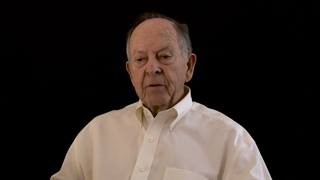6:23 | Threatened with the Army draft in his last year of Georgia Tech, Dick Almand enlisted in the Air Corps and entered the training for flight crews. Classified as a navigator, he was sent to radar navigator school, where he learned the new technology. A broken ankle delayed his graduation and he narrowly missed going to Europe on a B-17 crew. Instead, he went to B-29's.
Keywords : Dick Almand Columbus GA Atlanta GA ROTC Enlisted Reserve Corps (ERC) Georgia Institute of Technology (Georgia Tech) Fort McPherson Aberdeen Proving Ground ordnance Keesler Air Force Base Butler University Indianapolis IN San Antonio TX pilot bombardier navigator radar Ellington Field Houston TX Phoenix AZ Boca Raton FL B-17 B-29 Lincoln NE

Assigned as radar navigator on the latest B-29 model, Dick Almand had to wait in the States and extend his training because the air field in Guam was still under construction. In fact, the war in Europe came to an end while he was waiting. Once he got to the Pacific, his squadron began long range night missions over Japan.
On his first combat mission, B-29 radar navigator Dick Almand recalls a vicious crosswind that caused the bombs to miss the target. The squadron commander was on board to observe and he didn't get vexed at that, but what the ground crew discovered when they returned caused some ruckus.
On his last combat flight, B-29 radar navigator Dick Almand's target was 300 miles past the main Japanese Islands. At the time, it was the longest bombing mission ever attempted. They used the Norden bombsight but, since all their missions were at night, the bombardier didn't actually look through the sight. That's when the radar navigator came into play.
Dick Almand recalls dodging rats and watching movies in the rain at the air field in Guam in between bombing missions. The unexpected use of the atomic bomb ended the war and his biggest problem became flight time. Everyone in his squadron needed the scarce hours to maintain their flight pay.